Results
-
 £169.99
£169.99Leonardo - Otto M. Schwarz
Leonardo by Otto M. Schwarz is an 11-minute work for Concert Band based on the life and work of Leonardo da Vinci.Born in Italy in 1452, da Vinci was a polymath of the Renaissance period whose interests included astronomy, philosophy, science and mathematics as well as the visual arts. He is considered one of the greatest painters of all time - who does not know of his famous 'Mona Lisa' or 'The Last Supper'?Inspired by da Vinci's notebooks, or codices, this composition takes the listener on a journey through the artist's incredible career. Through his music, Schwarz brings da Vinci back to life. The listener will beable to sense the passion, and the urge for innovation that set da Vinci apart as one of the most remarkable thinkers of the 16th century.This set includes a score and parts.
Estimated dispatch 7-14 working days
-
£60.99
Der Zaubermarsch - Rob Ares
On 30th September 1791, a few months before his death, the opera "Die Zauberflote" (The Magic Flute) by Wolfgang Amadeus Mozart was given its first performance. It was remarkable that despite his ill health and his disastrous financial situation he was able to compose a work of such comic genius. Mozart composed the overture in the two days before the premier of the opera and it is on this overture that this transcription is based. To perform the work 'a la Mozart' only the timpani part should be used, the additional percussion parts have been added by the arranger and are therefore optional.Mozart 40th SymphonyThe Austrian composer Wolfgang Amadeus Mozart lived atragically short life of thirty-five years. Towards the end of his life in the summer of 1788, he wrote three symphonies in the span of a little over six weeks. His Symphony No.40 in G Minor was one of those great works. This setting of the first movement from that Symphony provides ample demonstration of the composer's grace, inventiveness and pervasive sense of humour, which can be found throughout his music.
Estimated dispatch 7-14 working days
-
£60.99
Dolce Vita - Wim Laseroms
The old German fishing village of Hartheim is situated on the river plain of the Rhine between the mountain Kaiserstuhl and the countryside Markgrflerland. Its inhabitants enjoy life, and they know how to celebrate and have a good time. Wim Laseroms has captured the relaxed atmosphere of the village in this cheerful march. Dolce Vita is an expression of thanks to the band's most loyal fans for their support in the past, and it expresses how music can have a positive effect on the quality of life in a village.
Estimated dispatch 7-14 working days
-
£118.99
Asteroid - Otto M. Schwarz
Asteroids and comets have played an important role throughout the history of life on earth. It is quite probable that the dinosaurs have been exterminated by an asteroid's impact in the Gulf of Mexico. Huge tidal waves and fire storms wiped out all life. This is the year 2067 according to the Christian calendar. A collision has just taken place in the asteroid belt between Mars and Jupiter and caused an asteroid to enter the earth's power of gravitation. It is instoppably approaching the blue planet. As its peoples have been fighting each other continuously, they missed the building of a global defence system against dangers coming from space. A scanner records the asteroid andimmediately sends a message to the President of the Anglo-American Union. The probability that the asteroid will hit the earth is judged 50% by the experts. Plans are made to shoot the celestial body with rockets live with hydrogen bombs or laser guns in order to throw it off its track, but they fail. The asteroid's size seems to threaten the existence of mankind. Those in the know stare at the night sky in bewilderment. But for the time being, there is still peace on earth....
Estimated dispatch 7-14 working days
-
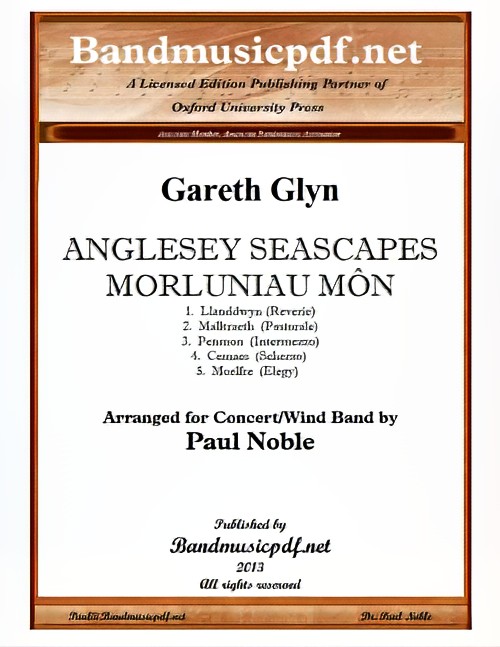 £240.00
£240.00Anglesey Seascapes (Concert Band - Score and Parts) - Glyn, Gareth - Noble, Paul
Gareth Glyn lives on the island of Anglesey, where the encircling sea has always been indivisible from the mythology, history and everyday life and work of its people. This cycle of short miniatures, in a light music vein, seeks to represent various aspects of the sea as seen from five vantagepoints around the coast of Anglesey. The whole work is bound together by recurring musical motifs which change their character according to the prevailing mood. 1. Llanddwyn (Reverie): Island of the Welsh patron saint of lovers, Dwynwen, whose marriage to Maelon was never to be, and who dedicated her life to God. 2. Malltraeth (Pastorale): A brisk walk along Cob Malltraeth, a high dyke built to keep out the sea. 3. Penmon (Intermezzo): From a vantage point by the sacred priory of St Seiriol, old sailing ships and modern yachts can be seen scudding by in Regatta week. 4. Cemaes (Scherzo): The bustle of children's play and donkey-rides on the beach in midsummer. 5. Moelfre (Elegy): In remembrance of innumerable souls lost in shipwrecks off this coast, including the Royal Charter with its loss of 452 lives.
Estimated dispatch 7-14 working days
-
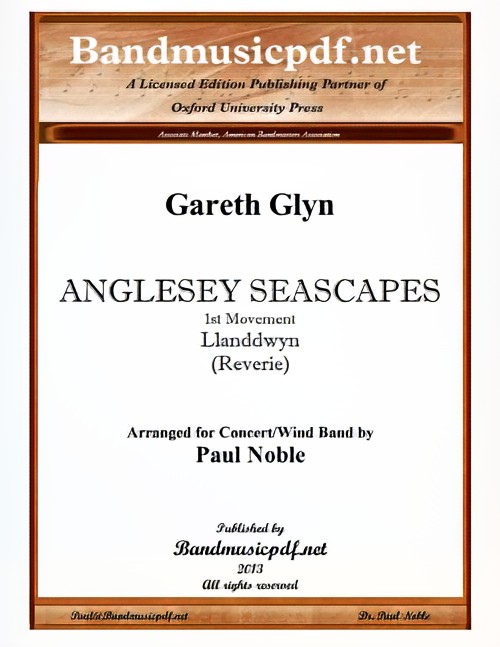 £65.00
£65.00Anglesey Seascapes, 1st Movement (Concert Band - Score and Parts) - Glyn, Gareth - Noble, Paul
Gareth Glyn lives on the island of Anglesey, where the encircling sea has always been indivisible from the mythology, history and everyday life and work of its people. This cycle of short miniatures, in a light music vein, seeks to represent various aspects of the sea as seen from five vantagepoints around the coast of Anglesey. The whole work is bound together by recurring musical motifs which change their character according to the prevailing mood. 1. Llanddwyn (Reverie): Island of the Welsh patron saint of lovers, Dwynwen, whose marriage to Maelon was never to be, and who dedicated her life to God. 2. Malltraeth (Pastorale): A brisk walk along Cob Malltraeth, a high dyke built to keep out the sea. 3. Penmon (Intermezzo): From a vantage point by the sacred priory of St Seiriol, old sailing ships and modern yachts can be seen scudding by in Regatta week. 4. Cemaes (Scherzo): The bustle of children's play and donkey-rides on the beach in midsummer. 5. Moelfre (Elegy): In remembrance of innumerable souls lost in shipwrecks off this coast, including the Royal Charter with its loss of 452 lives.
Estimated dispatch 7-14 working days
-
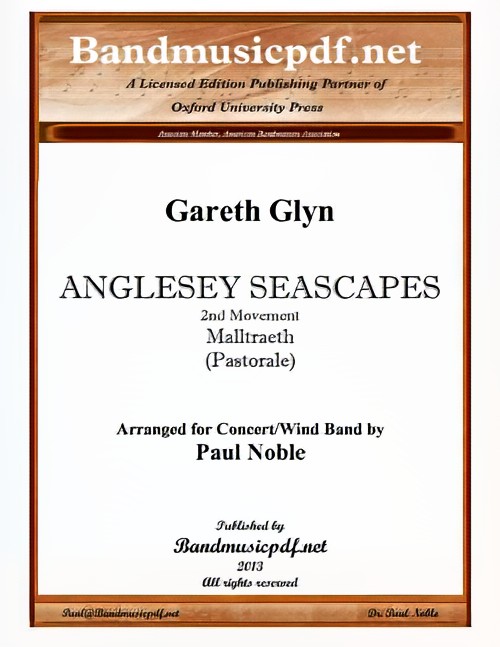 £65.00
£65.00Anglesey Seascapes, 2nd Movement (Concert Band - Score and Parts) - Glyn, Gareth - Noble, Paul
Gareth Glyn lives on the island of Anglesey, where the encircling sea has always been indivisible from the mythology, history and everyday life and work of its people. This cycle of short miniatures, in a light music vein, seeks to represent various aspects of the sea as seen from five vantagepoints around the coast of Anglesey. The whole work is bound together by recurring musical motifs which change their character according to the prevailing mood. 1. Llanddwyn (Reverie): Island of the Welsh patron saint of lovers, Dwynwen, whose marriage to Maelon was never to be, and who dedicated her life to God. 2. Malltraeth (Pastorale): A brisk walk along Cob Malltraeth, a high dyke built to keep out the sea. 3. Penmon (Intermezzo): From a vantage point by the sacred priory of St Seiriol, old sailing ships and modern yachts can be seen scudding by in Regatta week. 4. Cemaes (Scherzo): The bustle of children's play and donkey-rides on the beach in midsummer. 5. Moelfre (Elegy): In remembrance of innumerable souls lost in shipwrecks off this coast, including the Royal Charter with its loss of 452 lives.
Estimated dispatch 7-14 working days
-
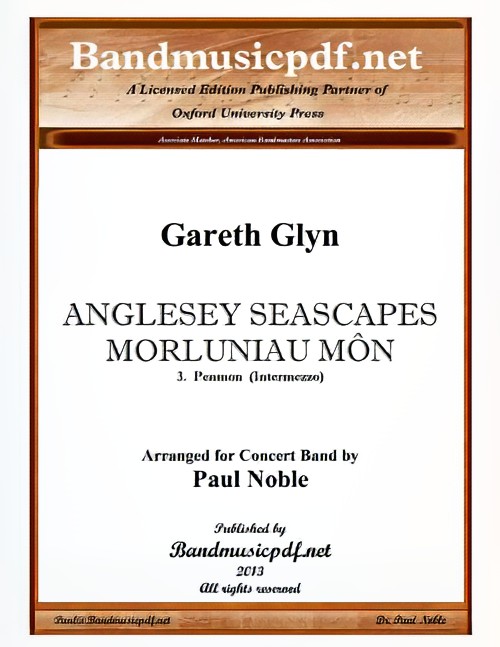 £65.00
£65.00Anglesey Seascapes, 3rd Movement (Concert Band - Score and Parts) - Glyn, Gareth - Noble, Paul
Gareth Glyn lives on the island of Anglesey, where the encircling sea has always been indivisible from the mythology, history and everyday life and work of its people. This cycle of short miniatures, in a light music vein, seeks to represent various aspects of the sea as seen from five vantagepoints around the coast of Anglesey. The whole work is bound together by recurring musical motifs which change their character according to the prevailing mood. 1. Llanddwyn (Reverie): Island of the Welsh patron saint of lovers, Dwynwen, whose marriage to Maelon was never to be, and who dedicated her life to God. 2. Malltraeth (Pastorale): A brisk walk along Cob Malltraeth, a high dyke built to keep out the sea. 3. Penmon (Intermezzo): From a vantage point by the sacred priory of St Seiriol, old sailing ships and modern yachts can be seen scudding by in Regatta week. 4. Cemaes (Scherzo): The bustle of children's play and donkey-rides on the beach in midsummer. 5. Moelfre (Elegy): In remembrance of innumerable souls lost in shipwrecks off this coast, including the Royal Charter with its loss of 452 lives.
Estimated dispatch 7-14 working days
-
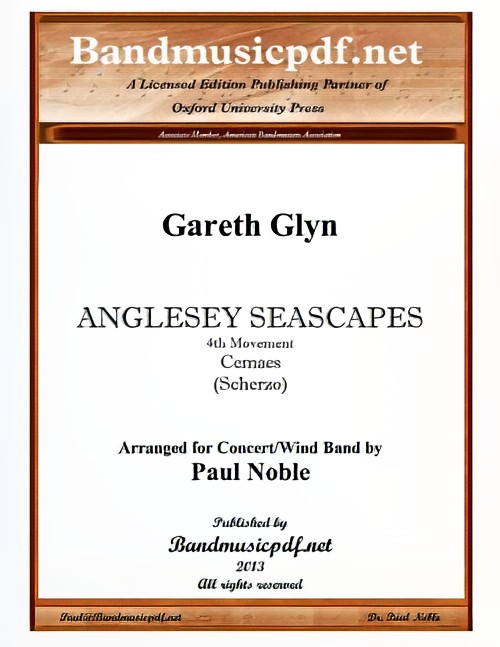 £65.00
£65.00Anglesey Seascapes, 4th Movement (Concert Band - Score and Parts) - Glyn, Gareth - Noble, Paul
Gareth Glyn lives on the island of Anglesey, where the encircling sea has always been indivisible from the mythology, history and everyday life and work of its people. This cycle of short miniatures, in a light music vein, seeks to represent various aspects of the sea as seen from five vantagepoints around the coast of Anglesey. The whole work is bound together by recurring musical motifs which change their character according to the prevailing mood. 1. Llanddwyn (Reverie): Island of the Welsh patron saint of lovers, Dwynwen, whose marriage to Maelon was never to be, and who dedicated her life to God. 2. Malltraeth (Pastorale): A brisk walk along Cob Malltraeth, a high dyke built to keep out the sea. 3. Penmon (Intermezzo): From a vantage point by the sacred priory of St Seiriol, old sailing ships and modern yachts can be seen scudding by in Regatta week. 4. Cemaes (Scherzo): The bustle of children's play and donkey-rides on the beach in midsummer. 5. Moelfre (Elegy): In remembrance of innumerable souls lost in shipwrecks off this coast, including the Royal Charter with its loss of 452 lives.
Estimated dispatch 7-14 working days
-
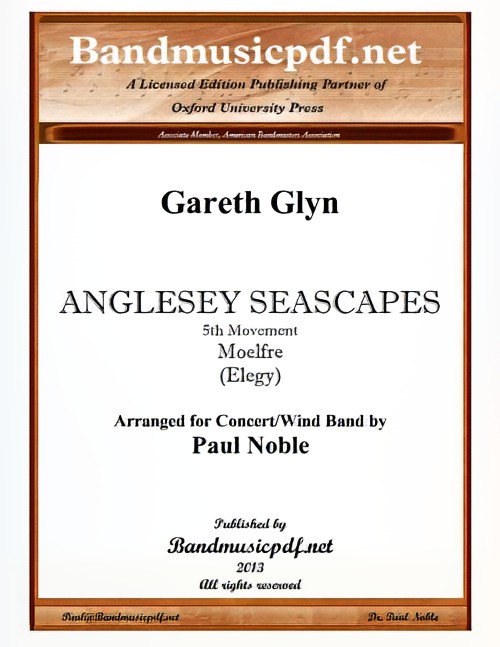 £65.00
£65.00Anglesey Seascapes, 5th Movement (Concert Band - Score and Parts) - Glyn, Gareth - Noble, Paul
Gareth Glyn lives on the island of Anglesey, where the encircling sea has always been indivisible from the mythology, history and everyday life and work of its people. This cycle of short miniatures, in a light music vein, seeks to represent various aspects of the sea as seen from five vantagepoints around the coast of Anglesey. The whole work is bound together by recurring musical motifs which change their character according to the prevailing mood. 1. Llanddwyn (Reverie): Island of the Welsh patron saint of lovers, Dwynwen, whose marriage to Maelon was never to be, and who dedicated her life to God. 2. Malltraeth (Pastorale): A brisk walk along Cob Malltraeth, a high dyke built to keep out the sea. 3. Penmon (Intermezzo): From a vantage point by the sacred priory of St Seiriol, old sailing ships and modern yachts can be seen scudding by in Regatta week. 4. Cemaes (Scherzo): The bustle of children's play and donkey-rides on the beach in midsummer. 5. Moelfre (Elegy): In remembrance of innumerable souls lost in shipwrecks off this coast, including the Royal Charter with its loss of 452 lives.
Estimated dispatch 7-14 working days
